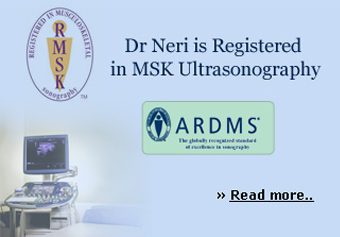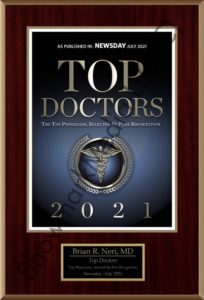Check out some information on our most common shoulder injuries. If you are in need of medical attention for any of the following procedures, please feel free to contact us as soon as possible to schedule your appointment.
Rotator cuff is the group of tendons in the shoulder joint providing support and enabling wider range of motion. Major injury to these tendons may result in tear of these tendons and the condition is called as rotator cuff tear. It is one of the most common causes of shoulder pain in middle aged adults and older individuals. It may occur with repeated use of arm for over head activities, while playing sports or during motor accidents. Rotator cuff tear causes severe pain, weakness of the arm, and crackling sensation on moving shoulder in certain positions. There may be stiffness, swelling, loss of movements, and tenderness in the front of the shoulder.
Rotator cuff tear is best viewed on magnetic resonance imaging. Symptomatic relief may be obtained with conservative treatments – rest, shoulder sling, pain medications, steroidal injections and certain exercises. However surgery is required to fix the tendon back to the shoulder bone. Rotator cuff repair may be performed by open surgery or arthroscopic procedure. In arthroscopy procedure space for rotator cuff tendons will be increased and the cuff tear is repaired using suture anchors. These anchor sutures help in attaching the tendons to the shoulder bone. Following the surgery you may be advised to practice motion and strengthening exercises.
Shoulder impingement is also called as swimmer’s shoulder, tennis shoulder, or rotator cuff tendinitis. It is the condition of inflammation of the tendons of the shoulder joint caused by motor vehicle accidents, trauma, and while playing sports such as tennis, baseball, swimming and weight lifting.
Individuals with shoulder impingement may experience severe pain at rest and during activities, weakness of the arm and difficulty in raising the hand overhead. X-rays and MRI scans show the injury and inflammation. Shoulder impingement can be treated with rest, ice packs, anti-inflammatory drugs, and avoiding the activities involving the shoulder. Physical therapy may be advised to strengthen the muscles and steroid injections may be given if pain persists. Arthroscopic surgery is recommended if the rotator cuff tendons are torn and to remove the bony spurs.
Shoulder arthroscopy is a surgical procedure in which an arthroscope is inserted into the shoulder joint. The benefits of arthroscopy are smaller incisions, faster healing, a more rapid recovery, and less scarring. Arthroscopic surgical procedures are often performed on an outpatient basis and the patient is able to return home on the same day.
Arthroscopy may be recommended for shoulder problems such as:
- Evaluation and treatment of instability
- A torn or damaged cartilage ring (labrum) or biceps tendon
- A torn rotator cuff
- Stiffness of the shoulder
- Subacromial decompression
- Arthritis of the end of the clavicle
- Treatment of frozen shoulder
- Removal of loose bodies
- Debridement / drainage of shoulder joint infection
Arthroscope is a small fiber-optic viewing instrument made up of a tiny lens, light source and video camera. The television camera attached to the arthroscope displays the image of the joint on a television screen, allowing the surgeon to look, throughout the shoulder- cartilage, ligaments, and the rotator cuff.
The surgeon makes small incisions around the joint area. In one portal, the arthroscope is inserted to view the shoulder joint. Along with the arthroscope, sterile solution is pumped to the joint which expands the shoulder joint, giving the surgeon a clear view and room to work. Other portal is used for the insertion of surgical instruments to probe various parts within the joint to repair the damaged shoulder.
Arthroscopy is much less traumatic to the muscles, ligaments and tissues than the traditional method of surgically opening the shoulder with long incisions (open techniques).
Following the surgery, your surgeon may recommend you to practice certain measures for better outcomes. Pain medications will be provided, bandage will be given around the operated shoulder which can be removed after 24 hours and dressings can be placed to cover the wounds. Slight swelling of the shoulder may be present after the surgery which is normal. Placing ice-packs on the shoulder for about 20 minutes, 3-4 times a day helps reduce the swelling. You can return to normal activities when you feel comfortable and a follow-up visit should be scheduled 7-10 days after surgery to monitor your progress.
Frozen shoulder is the condition of painful shoulder limiting the movements because of pain and inflammation. It is also called as adhesive capsulitis and may progress to the state where an individual may feel very hard to move the shoulder. It is more common in older adults aged between 40 and 60 years and is more common in women than men.
Frozen shoulder is caused by inflammation of the ligaments holding the shoulder bones to each other. The shoulder capsule becomes thick, tight, and the stiff bands of tissue called adhesions may develop. Individuals with shoulder injury, shoulder surgeries, shoulder immobilized for longer period of time, other disease conditions such as diabetes, hypothyroidism, hyperthyroidism, Parkinson’s disease and cardiac diseases are at risk of developing frozen shoulder.
Frozen shoulder may cause pain and stiffness and limit the movements of shoulder. Condition can be diagnosed by the presenting symptoms and radiological diagnostic procedures such as X-rays or MRI scans. Treatment for frozen shoulder includes nonsteroidal anti-inflammatory drugs and steroid injections for pain, treatment of underlying risk factors, and shoulder arthroscopy surgery. During surgery, the scar tissue will be removed and tight ligaments, if any, will be dissected. Following surgery physical therapy will be advised to bring full range of motion and strengthen the muscles.
Shoulder joint replacements are usually done to relieve pain and when all non-operative treatment to relieve pain have failed.
https://www.orthoillustrated.com/shoulder/arthritis#Arthritis
Shoulder instability is a chronic condition that causes frequent dislocations of the shoulder joint. A dislocation occurs when the end of the humerus (the ball portion) partially or completely dislocates from the glenoid (the socket portion) of the shoulder. A partial dislocation is referred to as a subluxation whereas a complete separation is referred to as a dislocation. The common symptoms of shoulder instability include pain with certain movements of the shoulder; popping or grinding sound may be heard or felt, swelling and bruising of the shoulder may be seen immediately following subluxation or dislocation. Visible deformity and loss of function of the shoulder occurs after subluxation or sensation changes such as numbness or even partial paralysis can occur below the dislocation as a result of pressure on nerves and blood vessels.
The risk factors that increase the chances of developing shoulder instability include:
- Injury or trauma to the shoulder
- Falling on an outstretched hand
- Repetitive overhead sports such as baseball, swimming, volleyball or weightlifting
- Loose shoulder ligaments or an enlarged capsule
Treatment
The goal of conservative treatment for shoulder instability is to restore stability, strength, and full range of motion. Conservative treatment measures may include the following:
- Closed Reduction: Following a dislocation, your orthopaedist can often manipulate the shoulder joint, usually under anesthesia, realigning it into proper position. Surgery may be necessary to restore normal function depending on your situation
- Medications: Over the counter pain medications and NSAID's can help reduce the pain and swelling. Steroidal injections may also be administered to decrease swelling
- Rest: Rest the injured shoulder and avoid activities that require overhead motion. A sling may be worn for 2 weeks to facilitate healing
- Ice: Ice packs should be applied to the affected area for 20 minutes every hour
When these conservative treatment options fail to relieve shoulder instability, your surgeon may recommend shoulder stabilization surgery. Shoulder stabilization surgery is done to improve stability and function to the shoulder joint and prevent recurrent dislocations. It can be performed arthroscopically, depending on your particular situation, with much smaller incisions. Arthroscopy is a surgical procedure in which an arthroscope, a small flexible tube with a light and video camera at the end, is inserted into a joint to evaluate and treat of the condition. The benefits of arthroscopy compared to the alternative, open shoulder surgery are smaller incisions, minimal soft tissue trauma, less pain leading to faster recovery.




